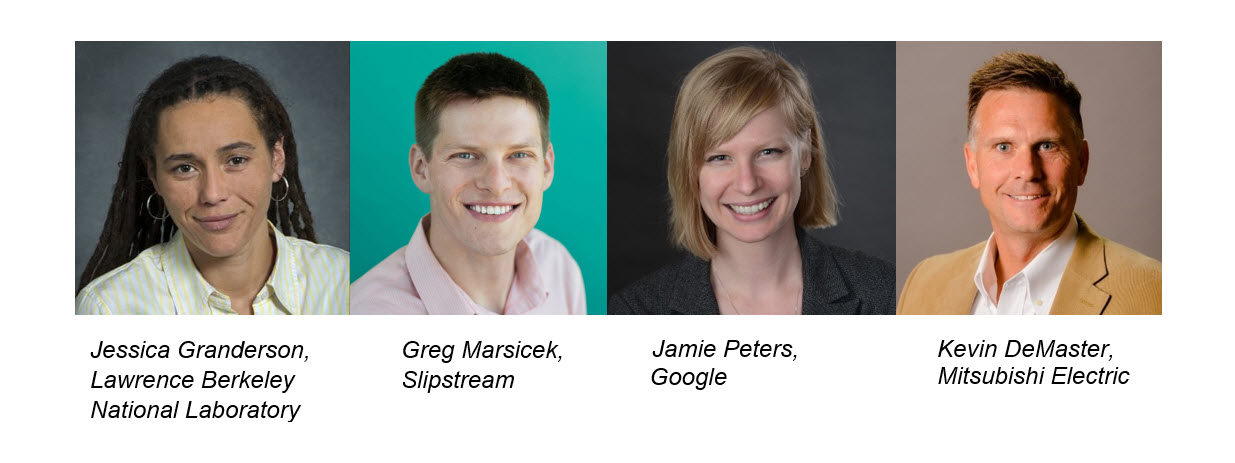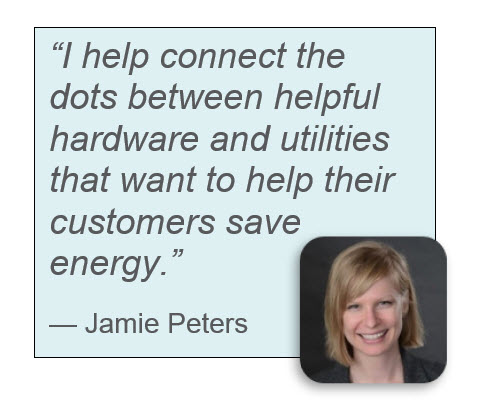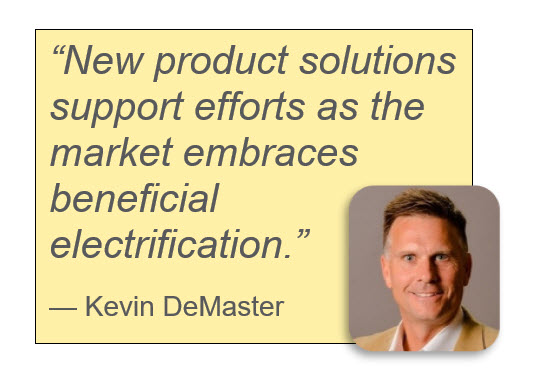by Carina Wallack
with Jessica Granderson, Greg Marsicek, Jamie Peters, and Kevin DeMaster
Do you think about renewables as the most innovative set of technologies for reducing emissions and meeting customer needs? If so, I want to challenge that perception: Energy efficiency should get more credit, and we’ve got the expert voices to prove it!
New efficient technologies provide less expensive — and more effective — solutions than you may realize. Efficiency reduces energy bills and improves air quality and comfort, while also enabling the success of renewable resources. To meet our nation’s climate goals, efficiency alone can contribute 50 percent of necessary emissions reductions by 2050, according to ACEEE.
Thank you all for providing your insights!

Responses have been edited for length. A full original version is available here.
 Briefly describe your company or organization’s work and your role.
Briefly describe your company or organization’s work and your role.
Jessica: Berkeley Lab is a multi-program science lab in the national laboratory system. We develop science and technology solutions by bringing together multidisciplinary teams of researchers and creating world-class tools for scientific discovery. I am a Staff Scientist and a Deputy Director of the Building Technology and Urban Systems Division. I lead our portfolio of R&D in commercial building analytics and advanced control technologies.
Greg: Slipstream is a nonprofit company which creates, tests, delivers and scales next generation energy efficiency and renewable energy solutions which move us toward a clean energy economy. I am an Energy Engineer who manages emerging technology projects, including conducting field monitoring and analysis.

Kevin: I’m the Manager of Efficiency and Utility Programs at Mitsubishi Electric Trane HVAC US, a global manufacturer of high efficiency cooling and heating equipment. My role is to partner with utilities and program implementation companies [to] support education and awareness of HVAC solutions. Residential and commercial mini-split heat pump and Variable Refrigerant Flow (VRF) products achieve energy savings and customer comfort.
What do you enjoy most about your work in energy efficiency?
Greg: I enjoy learning about cutting edge technologies and how they work to save energy over traditional technologies and practices. I find it challenging and rewarding to work to overcome market barriers and educate the public on new technologies. Jamie: I love the people aspect of my work. Throughout my career I’ve seen all sides of the utility energy efficiency industry and it truly does make an impact on people’s lives. There are so many jobs that these programs support – and create. We [launched] the Power Project to help people in need save energy. Our goal is, through our partners, to get 1 million smart thermostats into the homes of people that have limited means, and thus the highest energy burden. Kevin: Prior to Mitsubishi Electric, I supported the utility energy efficiency industry as an implementer for nearly 10 years. That experience has built a deep network of people interested in greatly increasing energy efficiency impacts. I now enjoy being an industry partner [and promoting] HVAC solutions for residential and commercial applications.
How has technology in energy efficiency changed during your career? How do you predict it will continue to change?
Jessica: The change that stands out most to me is the increase in connectivity in our buildings and the associated increase in the volume and availability of data. This in turn has opened the door to improved understanding of the many different aspects of performance that we are interested in, opportunities for more pervasive integration, and a foundation for new applications and services.
 Greg: Energy codes have adopted many technologies that were once considered “emerging technologies” such as demand controlled ventilation and mandating lighting controls. The market has adopted efficient technologies, such as LED lighting, as they have become more affordable. The efficiency market has [met a need for] buildings that are beneficial for both the environment and the occupants. I expect the demand for high performance buildings to continue to grow and for commercial energy codes to become more stringent.
Greg: Energy codes have adopted many technologies that were once considered “emerging technologies” such as demand controlled ventilation and mandating lighting controls. The market has adopted efficient technologies, such as LED lighting, as they have become more affordable. The efficiency market has [met a need for] buildings that are beneficial for both the environment and the occupants. I expect the demand for high performance buildings to continue to grow and for commercial energy codes to become more stringent.
Jamie: At risk of dating myself, when I began my career in sustainability, a programmable thermostat and insulation and air-sealing were considered innovative. Look how far we have come! Now, we’re looking at the house as a system that can be optimized to benefit both residents and the energy grid as a whole.

Are there new “cutting edge” energy efficiency technologies that you are excited about?
Jessica: I’m excited about the convergence of analytics and controls, as well as new types of data analytics. For example, we are working with a set of fault detection and diagnostics technology providers to develop methods that automate not just the identification of problems, but also their resolution. In an earlier-stage R&D effort, we are using computer vision and machine learning techniques in combination with drone and satellite/aerial imagery for improved asset and efficiency measure identification.
Greg: Coming from a northern climate, I am most excited about technologies that move us away from fossil fuel heating. Specifically, there is significant interest in “cold climate” variable refrigerant flow (VRF) systems. Recent advancements improve cold weather performance – making these electricity-based systems a viable option in cold climate locations. Another HVAC technology we are investigating is adsorbent air cleaning – a technology used to reduce the amount of outdoor air required by cleaning the indoor air.
 Jamie: Yes! I think that the work our partners such as Uplight are doing in synchronizing and optimizing energy use for grid goals is incredible. In order to meet climate goals, we’ll need to think bigger than a single house or single set of products and instead zoom out to how a whole neighborhood or town can save or shift energy at specific times to reduce the need for the most carbon-intensive fuels. Google plays a role in this through our demand response program called Rush Hour Rewards.
Jamie: Yes! I think that the work our partners such as Uplight are doing in synchronizing and optimizing energy use for grid goals is incredible. In order to meet climate goals, we’ll need to think bigger than a single house or single set of products and instead zoom out to how a whole neighborhood or town can save or shift energy at specific times to reduce the need for the most carbon-intensive fuels. Google plays a role in this through our demand response program called Rush Hour Rewards.
Kevin: Even industry “experts” rarely fully understand all the solutions and capabilities [so] conversations [are] always new and fresh. We investigate and develop advanced products that solve issues such as integration and controls with other home HVAC technologies, demand response solutions, and solutions that address the desire to integrate with, or displace, fossil fuels for space and water heating.
What new technologies are you hoping we will see in the energy efficiency field soon?
Jessica: Solutions for more streamlined and cost-effective interoperability between systems and applications. As distributed energy generation and grid interactivity become more central to how we operate our buildings, predictive controls that can integrate end uses and optimize for load flexibility, utility cost, and comfort will become increasingly important. In addition to new technologies there is still great value to be gained from scaling the adoption of existing, although still emerging technologies — a challenge that in many ways has proved equally as difficult as new technology development.
Greg: A technology that is gaining traction is automated demand response (ADR) and Grid-interactive Efficient Building (GEB). This reduces demand when the grid becomes overloaded by implementing building control logic to reduce or shift demand during peak load hours based on utility and grid operator’s ADR signals.
Jamie: I’d like to see more HVAC and other in-home service providers start offering smart home advisory and installation services that guide the customer to setting up the home as an ecosystem. This is an opportunity for energy programs as well, since customers don’t always optimize for energy efficiency as their first choice — entertainment or convenience or safety can be bigger drivers. In-home services routinely provided through a utility’s DSM programs such as direct install programs, energy audits, etc. would be an excellent fit.
Kevin: We have products in other parts of the world, such as air-to-water heat pumps, that we are evaluating. We are looking at solutions that might be specific to the U.S. market either because they fit a unique market need or because [they align with] the utilities’ energy efficiency programs or initiatives like beneficial electrification.
How can we best support technological innovation in energy efficiency? How can we get more people to work on developing new technologies within the efficiency field?
Jessica: One path to continued innovation is to ensure a thriving and sustained pipeline of diverse, inspired talent in our field. To that end, we can all endeavor to shine a bright light on the difficult problems that our field presents and the rewarding careers that can be built upon solving them.

Jamie: Innovation requires diverse and fresh perspectives, and the energy industry has historically been rather homogeneous. It’s important to purposefully invest in expanding access to the field such as geographically and culturally relevant workforce development and training. Another example is including R&D programs within a utility’s DSM portfolio and designing these programs in a way that allows and encourages historically underrepresented groups to apply. It’s important for utilities and regulators to collaborate [for] people-driven solutions to flourish in our industry.
Kevin: Awareness can be one of the biggest hurdles today. Transforming contractor and consumer understanding [can] overcome the perceptions of traditional equipment shortcomings. We support efforts that are focused around improving equipment. These pilots often become avenues to help facilitate innovation and professional development.

Thank you to my interviewees and to all the EE professionals working on new solutions for saving energy!
–Carina Wallack is a Policy Associate at E4TheFuture
